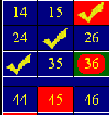 Video Keno Analysis from Sky Scientific
Video Keno Analysis from Sky Scientific
• Improve your video gaming experience
• Identify the best payout machines
• FREE Download of Dr Keno analysis software
• Features interactive play for some of today's hottest video games like IGT's Caveman Keno and Cleopatra Keno *
Percentage Return: What
Does It Mean?
%
%
%
%
%
%
%
%
We have all seen the claims, like “Our Machines Return 97% !”, or something similar. What does that mean exactly, in a practical sense? It means that on average, a player (let's call him "Joe”) putting $100 in a machine can expect to get $97 in return. Playing the remaining $97, Joe will on average be left with 0.97 × $97 or $94.09. If Joe were to continue in this fashion, he could expect to eventually lose virtually all of his starting bankroll of $100. And if we keep track of the total amount Joe has wagered in this process, we would expect to find that he has put a total of $3,333 into the machines. This is simply computed as $100 / ( 1 - 0.97). You can see that result here.
Joe Plays Video Keno
Joe is a smart guy. If this exact same losing result occurred every time
he played, it wouldn't be too long before he decided that casino gambling
wasn't much fun. But this is not Joe's actual experience. Occasionally—perhaps
even frequently—he comes home a winner. How is that possible with odds clearly
in favor of the “house”? The operative words are “on average.” Casinos bank
(literally) on those two words. A few thousand players who put a combined
$1 million into the machines at our fictional casino will usually net the casino
about $30,000 gross profit from the gaming. Most of the players will be net
losers, but a few will go home with more than they started. It is Joe's hope
that he will be among the winners!
Playing Smart !
Most casino video keno games return between 85% and 95% to the player. It wouldn't
be unusual to find games on two machines in the same casino, or even within a
single multi-game machine, that yield that great a variance in payout. How important
is the percentage difference? Considering our “average” play, we find that with an
85% return, Joe can wager a total of $667, or 667 plays of $1 each, before losing $100.
If he had chosen a 95% machine, Joe could expect to make 2,000 plays before losing
his bankroll. That is three times as many plays as before; or three times as long
and three times as many chances to maybe win a jackpot and go home a winner.
Which Video Keno Game Should I Play?
There are a lot of choices: standard video keno, Power Keno, Cleopatra Keno, Caveman Keno (including the Caveman Keno Plus version) and many more.
It would be great if casinos were in the habit of displaying the theoretical percentage
payout for each video game before you place your first bet. Unfortunately, they do not.
What you generally can find is a payout table. For video keno, there is a “pick” vs.
“catch” table that will tell you what you win if, for example, you “pick” seven numbers
and "catch” 5 of them in a game. Because we can assume that a particular number ball that
is drawn is no more or less likely than any other, the payout table plus description of
bonus provisions, if any, provide all the information needed to compute the game's
percentage return. The math is not too complicated, except for some of the bonus games
such as IGT's Cleopatra Keno and Caveman Keno. You can find explanations of the math as
well as some keno pay calculators on the internet by entering “keno payout” in your
favorite search engine.
What About 3-Reel Slots?
Can you use the same approach to calculate the percentage return for any common 3-reel
or 5-reel slot machine? In a word, NO. You will find a payout table that will show how
many credits you win with, for example, three “bars” or two “cherries”. And because,
typically, each reel has 22 possible positions with half of them displaying a symbol
and the other half blank, it would seem that one could compute the probability of
hitting any combination of symbols fairly readily. But you cannot. The payout table
does not provide enough information to calculate the percentage return for a 3-reel
or 5-reel slot machine.
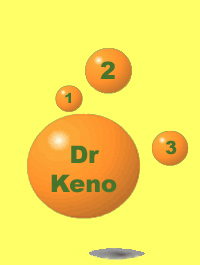 Dr Keno's Rx
Dr Keno's Rx
Dr Keno is an in-depth assessment tool designed to help both the casual and serious
keno player improve his or her video keno playing experience. Why is this important?
Simply because there is great variation in the expected payout among different games
and different machines. Most players understand that a basic video keno game will
have a different payout than one of the newer bonus games, such as IGT's Caveman Keno
or Cleopatra Keno, but many are unaware that payouts for the same game will vary
between casinos. Finally, multi-denominational machines will have different pay tables
within a single game. For example, playing with 25 cent credits will pay improved odds
over playing nickels.
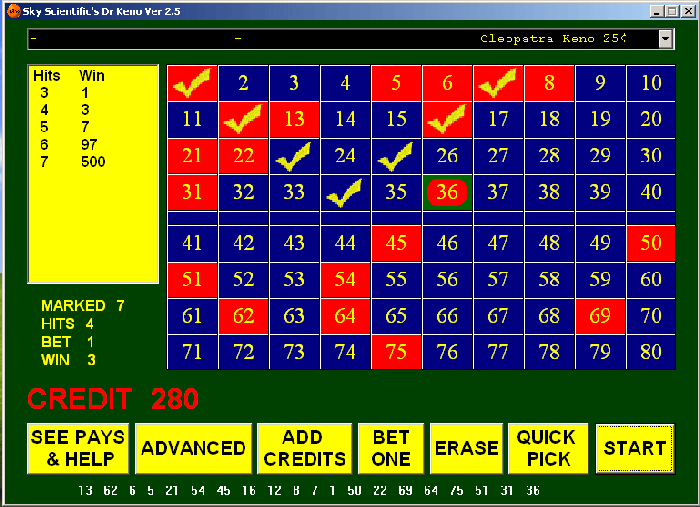
The Dr Keno software from Sky Scientific provides the video keno player with a sophisticated but easy-to-use tool to help identify the games that offer the best percentage returns, taking into account even the smallest variations in the payout tables that the player will invariably encounter. The basis for this tool is a mathematical analysis tool known as Monte Carlo Simulation. The figure below shows the screen display after running a ten million play Cleopatra Keno simulation with seven numbers picked and 25-cent credits:
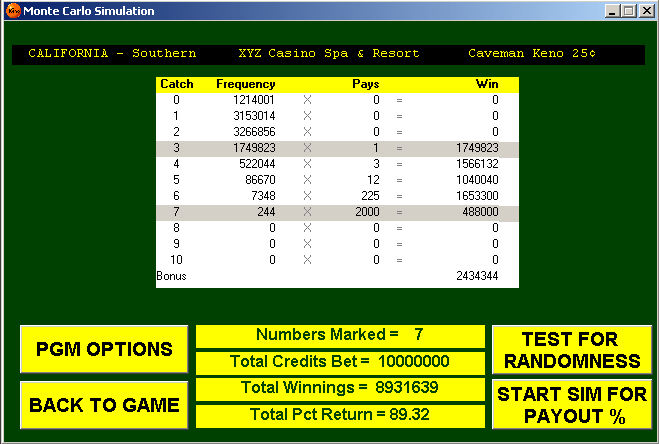
Dr Keno allows you to choose among several popular Keno games and match the pay table to an actual casino video game that you wish to play (you can print and use this form to record the pay table from the casino Keno game).
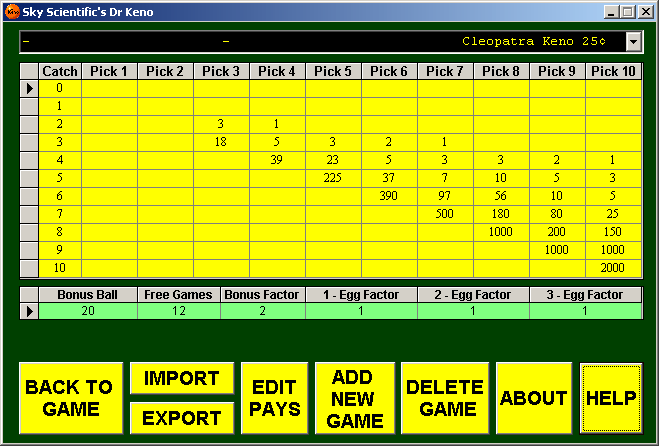
Why Session Results Are Important
Here is an example demonstrating the value of the Session Results feature of the Dr Keno
software: Suppose you have a choice between two games. The first game is the Cleopatra
Keno version as shown in the example above which returned 93.26%. Your second choice
is a "custom" keno game which promises a 100% return. One would expect a prudent player
to choose the game delivering a 100% return. But is that really the "best" choice?
Maybe not. Let's define our theoretical 100% return custom keno game as follows: The
player must pick ten numbers and is paid only if all ten numbers are caught. So the
paytable for Pick 10 would show zero payoff for 1 through 9 numbers caught and a very
large payoff for catching 10 out of 10. How large must that payoff be to yield an overall
100% return? It is equal to the odds of catching 10 out of 10, about 8,911,700 to 1.
Summarizing, the player lucky enough to catch 10 will win $8,911,700 with a $1 bet.
Let's call this custom keno game "Catch All 100%" and run a simulation of 10 million
plays to compare it with the Cleopatra 25 results. In one such simulation, we found
that all ten picks were caught only one time in 10 million plays. The summary
statistics are shown below.
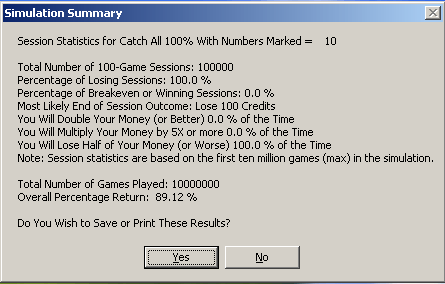
Note that for this simulation run, the percentage return was
89.12%. Why wasn't it closer to 100%, as promised? With a low number of winning games
and a high payoff per win, the percent return can be expected to vary considerably
from one simulation to the next. For example, if there had been one more winning game
(two instead of one) the final percent return would have risen to 178.23%. One could
expect a result closer to the theoretical 100% return if a greater number of games were
played in the simulation. The Dr Keno software permits simulation runs of up to one
billion games. Now let's review some of the session results (each session starts with 100 credits):
● Percentage of Losing Sessions: 100.0% (actually 99.99999%)
● Most Likely End of Session Outcome: Lose 100 credits.
What conclusion can be drawn from the above? While our custom game will indeed generate
a theoretical 100% return, playing such a game in a casino would prove to be frustrating
indeed! A lucky winner can be expected only once in 8,911,710 plays. At ten seconds per
game, it would require nearly 3 years of continuous play―twenty-four hours per day,
seven days each week―before one should expect the big win. So which of the two games
would you choose to play? Although this is an extreme example, it proves the point that
percent return shouldn't be the one-and-only consideration when evaluating a casino game
to play. The session statistics feature included in the Dr Keno software provides you
with valuable additional information to facilitate your evaluation.
You can download and install the free evaluation version of Sky Scientific's Dr Keno play and analysis software and have it running in minutes:
Free Download of Dr Keno Version 3.0
 1.
System Requirements: Windows® XP (Service Pack 3) or Windows® Vista
or Windows® 7, 8, 10 or 11.
1.
System Requirements: Windows® XP (Service Pack 3) or Windows® Vista
or Windows® 7, 8, 10 or 11.2. Click the “Download” button below and save the install file: DrKeno30-setup.exe
3. Open the download file to install. After installation is complete, start the Dr Keno program by double-clicking on the desktop icon. You will have nearly 30 days to review the program features and operation. If you are pleased with the program, you may order the Activation Key below to convert your installed evaluation version into the full-featured and licensed version of Dr Keno.
4. If you experience problems with the download, installation or program operation see info here.
If you have already downloaded and installed the free Evaluation Version of Dr Keno . . .
We believe that after spending a short time
with our free software, you will find it to be invaluable in maximizing
your casino gaming experience as well as providing hours of enjoyable
entertainment. We have made the Dr Keno download available to you free
of charge so that you may make an intelligent, risk-free evaluation of
the software. If your experience running and evaluating the software has
proved favorable, order the License Activation Key below to transform your
installed evaluation version of Dr Keno into the licensed version of our
software.
Important: Enter below the Dr Keno
Installation ID from your trial version (before clicking the Add-to-Cart
button) so that we can send you the
correct Activation Key for your installation. The Installation ID is a
ten-digit number followed by " - 30 " shown on the program About Tab or
Startup Screen.
Dr Keno ver 3.0 License Activation Key
$ 10
